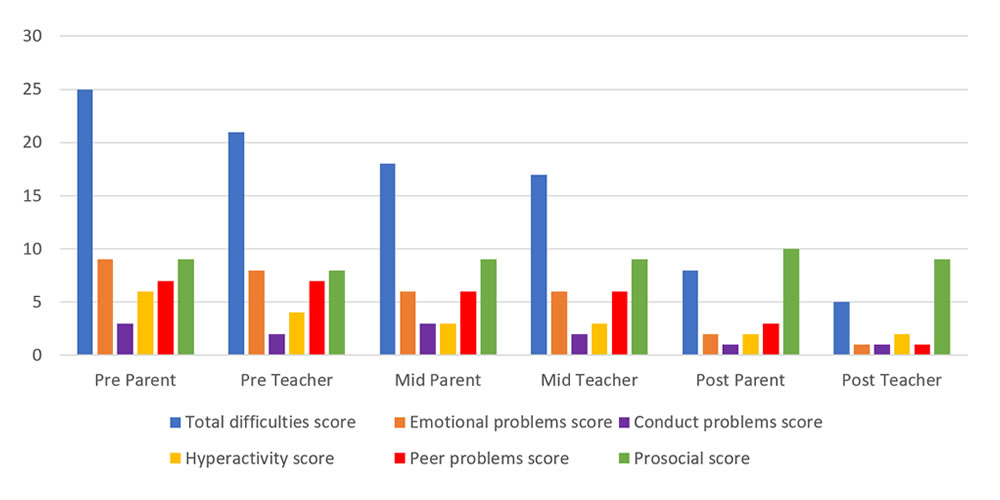Lacey was 12 years old when KidsAid started working with her. She was referred to us by her school to provide therapy for the trauma she had experienced during the early years of her childhood.
Lacey was removed from her mother’s care in 2018 after her school alerted children services when Lacey attended school with untreated burns. When Lacy was taken to the hospital, she alleged repeated significant physical chastisement including the use of implements, witnessing repeated domestic violence between Mum and her ex-partner and being left alone regularly at night when Lacey’s mother would go out. Lacey was also unclean and malnourished.
Since being removed from her mother, Lacey was placed in Foster Care. Several placements had broken down during the past 3 years which added to Lacey’s anxiety and distress. As placements broke down, she was moved from home to home and with that she was also placed in various schools within the county, which made it difficult for her to build relationships with her peers and amplified her mistrust in adults.
At point of referral Lacey had just been placed with her foster carer, Jill.
The assessment for Lacey included a carer assessment to measure attachment, developmental milestones and presenting difficulties at home; a risk assessment to identify safeguarding concerns; and an observation/introduction session for the therapist to assess emotional regulation and behaviours.
Jill and Lacey’s schoolteacher advised that Lacey often presented with varying levels of distressing behaviours where she would scratch at her skin and pull at her hair. Lacey was also incredibly withdrawn and avoided engaging in class.
Strength and difficulties questionnaires were also completed by Jill and Lacey’s schoolteacher, which provided a baseline to measure progress throughout the intervention.
The assessment identified attachment difficulties, high levels of anxiety, self-harming concerns and low self-esteem.
Following KidsAid’ assessment it was recommended that Lacey have 30 weeks of creative therapy sessions. The aim of the sessions was to give Lacey a confidential space to safely work through the traumas she had been through with her therapist, to express herself through the use of creative art and play, to reduce her anxiety and improve her self-esteem.
During the first few sessions Lacey was withdrawn and reluctant to engage. It took her some time to feel comfortable to make art and to build trust in a new adult, her therapist. However, as sessions continued Lacey grew more confident and she began to move more freely around the space and by session 4 she was using materials independently and began to develop trust in the therapeutic relationship by testing what was safe and not safe to bring to the sessions through the communication and vulnerability of her artwork.
Themes begun to emerge that the therapist supported Lacey in exploring, including strong negative feelings of self, such as guilt, shame, and low confidence. The therapist was able to gently challenge some of these thoughts, which helped Lacey reflect on her understanding of self.
Lacey also began to make verbal links between the images she was creating and her feelings: as she painted, she began to feel able to revisit some of her traumatic experiences so that they could be contained into the sessions and her art making.
An interim review meeting was held at the half-way point of Lacey’s therapeutic interventions, where her therapist met with Lacey’s carer Jill, Lacey’s social worker and her schoolteacher.
At the meeting it was discussed that Lacey was engaging well with her sessions and had started exploring difficult memories and emotions. Lacey’s therapist reflected that Lacey’s confidence was slowly growing, which was echoed by Jill, who shared that she Lacey was starting to come out of her shell at home.
At this meeting, a midway strength and difficulties questionnaire was completed by Jill and Lacey’s schoolteacher. Outcomes from these questionnaires demonstrated slight improvements in all areas.
Around week 16, Lacey began to play with the sand tray and figures. To begin with the characters seemed to be quite chaotic with the ‘bad’ characters always beating the ‘good’ characters. Through this play Lacey explored the theme of safety and that of the victim and rescuer. Within the character’s world it would seem all hope was lost, but at the last minute one character would swoop in and save the day. This continued for a few weeks until Lacey was able to move on and then the ‘good’ characters seemed more able to defeat the ‘bad’ characters. This coincided with her improvements in self-esteem and the last time she played in the sand all the ‘bad’ characters moved over to the ‘good’ team.
Lacey was also able to talk about her recent achievements in class, talking about herself in a positive way and recognising herself as a kind and thoughtful girl. Furthermore, Lacey was showing her increasing confidence, as she reflected on the friendships she had made with a group of girls in her class.
As Lacey’s self-esteem improved, episodes of self-harm were becoming more infrequent. Instead, Lacey was able to regulate herself using breathing exercises and mindfulness exercises that her therapist had shared with her.
In Lacey’s final session of therapy, she spoke about the positive effects of being able to “leave” her painful memories with her therapist, so she did not have to carry them with her anymore. Therapy with KidsAid enabled Lacey to label her feelings easier and have the freedom to express herself in a space where she felt validated and would receive neither judgement nor punishment.
A final review meeting was held at the end of Lacey’s therapy intervention and post therapy strength and difficulty questionnaires were completed by Jill and Lacey’s schoolteacher.
In all areas, outcomes evidenced progress for Lacey.

Furthermore, Lacey’s school provided feedback, advising that Lacey is engaging better in school and building positive relationships with her peers. Jill shared that Lacey continues to thrive at home, and it is planned that Lacey will remain living with her long-term.